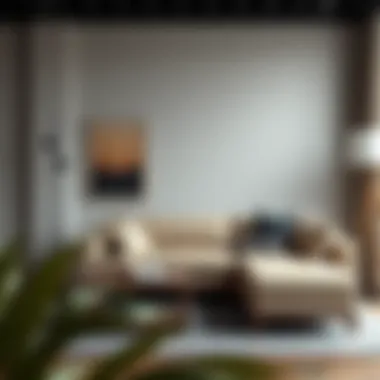Discovering the Mini Corner Couch for Modern Spaces


Intro
In contemporary living spaces, where square footage often comes at a premium, the mini corner couch is rapidly becoming a game-changer. Its design not only maximizes seating but also adds a stylish flair to any room. This guide takes you through the nuances of selecting and incorporating the mini corner couch into your home, offering insights that speak to both aesthetics and functionality.
As we delve deeper into the realms of furniture design trends and practical tips for selection, remember that the right piece doesn’t just fill a space; it enhances your living experience. So, whether you’re a seasoned interior designer, a meticulous homeowner, or someone looking to refresh your living space, this guide aims to serve as your go-to resource.
Furniture Design Trends
Current Trends in Furniture Design
The furniture landscape is ever-evolving. Currently, the shift towards minimalism and sustainability is palpable. Designers are focusing on clean lines, natural materials, and a palette that reflects calmness and sophistication. The mini corner couch fits snugly into this trend, offering a robust yet elegant seating solution without overwhelming a room with its presence.
Moreover, multi-functional furniture is in high demand. Brands are now crafting pieces that serve multiple purposes—think of a couch that can also transform into a guest bed or one that includes hidden storage compartments. Such versatility is a significant selling point for the mini corner couch, especially in urban settings where space is limited.
"Choosing furniture that is both functional and stylish is more important than ever in today’s design landscape."
Influential Designers to Follow
Keeping an eye on trailblazers in the industry can inspire your own design choices. Names like Kelly Wearstler and Studio McGee have made waves with their unique takes on modern comfort. They often highlight the mini corner couch in their projects, using it to optimize spaces while maintaining a chic aesthetic.
Additionally, brands like West Elm and Joybird have been at the forefront, presenting collections that cater to varying styles and preferences while emphasizing sustainability.
Practical Tips for Furniture Selection
Choosing the Right Materials
When selecting a mini corner couch, the material is paramount. Fabric choices like linen or cotton blend bear both comfort and durability, while leather is a luxurious, long-lasting option that adds character. However, beyond personal style, think about how these materials interact with your lifestyle.
Here are some material considerations:
- Cotton: Easy to clean, breathable, and comfortable.
- Linen: Natural fiber with a relaxed look that ages beautifully, but can be prone to wrinkling.
- Leather: Durable and stylish, yet can be more expensive and requires maintenance.
- Velvet: Soft and plush, adds a touch of sophistication but may need special care.
Maximizing Space with Smart Furniture Choices
Incorporating a mini corner couch is not just about aesthetics; it's also about making the most of what you have. A few practical ways to enhance functionality include:
- Positioning: Place the couch in a corner to free up pathways and create a cozy nook.
- Color Schemes: Lighter colors can make small spaces feel bigger, while dark hues add depth.
- Versatility: Choose a design with additional storage or modular components that adapt to your needs.
In essence, whether you're furnishing a small apartment or reimagining a family living room, understanding the core principles of design and selection can greatly elevate your space. Armed with this knowledge, your journey towards integrating a mini corner couch should be a breeze.
The Concept of a Mini Corner Couch
The mini corner couch has rapidly gained favor among modern homeowners, especially those navigating the challenges of smaller living spaces. These compact yet stylish sofas serve as the ultimate solution for maximizing seating while maintaining a harmonious layout in a room. Often characterized by their L-shape, mini corner couches create an inviting nook that encourages conversation and comfort without overwhelming a space.
Instead of traditional bulky furniture pieces, the mini corner couch offers versatility in design and placement. It's a practical choice for accommodating varied preferences, from intimate gatherings to lazy evenings curled up with a book. Homeowners, decorators, and interior designers alike often emphasize how this type of couch can redefine the usage of a room, allowing for a cozy atmosphere that adapts to different lifestyles.
Still, choosing a mini corner couch involves careful thought. Factors such as dimensions, materials, and aesthetic fit must be considered to ensure it complements not only the space but also the owner’s lifestyle. Recognizing these elements helps prevent buyer's remorse and ensures that the selected furniture enhances the room efficiently.
Defining the Mini Corner Couch
A mini corner couch is essentially a scaled-down version of a traditional sectional sofa, designed to fit snugly into corners while providing ample seating. These couches can vary in size and configuration, typically measuring between 70 to 90 inches on the longest side, making them ideal for tighter living spots. Their unique design allows for effective space utilization, turning even the smallest of rooms into functional and stylish living areas.
In essence, mini corner couches deliver a blend of comfort and style, combining the benefits of a larger couch with the adaptability required for confined areas. They can come with various features, including chaise lounges or built-in storage compartments, adding to their functionality. Therefore, they stand out as an exceptional choice for both urban apartment dwellers and those looking to enhance any cozy nook in their home.
Historical Context and Evolution
The concept of the corner couch is not a recent innovation. In fact, its roots trace back to early 20th-century design, when furniture aimed to make the most out of compact living spaces became prominent. Initially, these sofas appeared in larger homes but gradually made their way into modest residences as urban living gained traction and open floor plans became popular.
Over the decades, the design evolution of mini corner couches has mirrored changes in lifestyle and aesthetic values. The mid-century modern movement introduced clean lines and functional forms, influencing the look of these pieces. Today, manufacturers offer a plethora of designs, colors, and materials, catering to varied tastes—from the sleek minimalist styles favored in contemporary decor to the ornate, plush forms seen in classic setups.
As homeowners increasingly prioritize versatility and efficiency, the mini corner couch has become a staple, reflecting both historic trends and modern needs. This evolution signals not just a shift in design preferences but also an acknowledgment of how individuals live and utilize their spaces today. Understanding the journey of this furniture piece can offer insightful perspectives on current trends and future developments in interior design.
Design Variations
When considering a mini corner couch, the variations in design are pivotal for both aesthetic appeal and functional utility. The right design can seamlessly integrate the couch into your living area, while also reflecting your unique style. From contemporary flair to classic elegance, understanding these design variations is crucial in choosing a piece that not only fits the space but also enhances it. With a mini corner couch, it’s about maximizing both comfort and style without overwhelming a smaller living area.
Contemporary vs. Classic Designs
The clash between modern and traditional styles offers a fascinating exploration into how a mini corner couch can be adapted to various tastes.
Contemporary designs often boast clean lines and minimal ornamentation, focusing on a sleek and urban vibe. Materials like leather and breathable fabrics are common, making them easy to maintain. These couches might come with modular sections, allowing flexibility in arranging the sofa according to one’s needs or the layout of the room. In this busy digital age, where space is often at a premium, a contemporary mini corner couch can transform an ordinary nook into a stylish focal point.
On the other hand, classic designs offer a sense of timelessness. With rich fabrics, detailed craftsmanship, and soft, inviting shapes, they convey comfort and elegance. Think of tufted upholstery and wooden legs that hark back to yesteryears, evoking a feel of warmth and nostalgia. These designs may be particularly appealing to homeowners who appreciate vintage aesthetics and wish to create a cozy, inviting environment.


"Ultimately, the decision between contemporary and classic designs comes down to personal preference and how each style aligns with the broader decor of your home."
A balance between these two worlds can also be achieved; a classic design can feature contemporary color palettes or modular elements. This hybrid approach may appeal to those who appreciate a blend of old and new, allowing for a uniquely personal statement in a compact corner space.
Customization Options
Customization in furniture design is gaining traction, especially as people desire uniqueness in their living spaces. Mini corner couches are no exception; they come with plethora of customization choices.
First, consider fabric options. The choice of upholstery can drastically change the appearance and feel of the couch. From linen to velvet, each fabric brings its textures and vibe to the design. You could opt for durable synthetic blends if you have pets or kids, knowing they’ll withstand the wear and tear of daily life.
Then there's the shape and size to think about. Mini corner couches can often be tailored to fit specific measurements, making it possible to maximize your available space. Whether you need a shorter sofa to fit a narrow corner or rounded edges for a more inviting layout, customization lets you transform your ideas into reality.
Additionally, the color scheme plays a crucial role. Vibrant hues can enliven a room, while muted tones provide serenity. Many manufacturers now offer color swatches that help visualize how the selected shade will interact with the existing decor.
Finally, accessories like throw pillows and cushions can add flair without a complete overhaul of the couch itself. These small touches personalize the look, making it truly yours.
As a homeowner or designer, the more you exercise your options, the more likely you are to find a mini corner couch that speaks to your style while fulfilling functional needs.
Material Choices
When it comes to mini corner couches, the material choices are pivotal in determining not only the aesthetics but also the practicality and durability of the piece. The right material can transform a compact couch into a cozy nook or a stylish centerpiece. Homeowners, designers, and decorators must consider various factors when selecting materials, such as maintenance, comfort, and the intended use of the space.
Materials can significantly affect the overall design narrative of a living space. A couch upholstered in natural fabric might evoke a more organic and earthy feel, while a synthetic option may deliver a sleek modern touch. Knowing the strengths and weaknesses of each material can help buyers make informed decisions and achieve the desired ambiance in their homes.
Natural Fabrics: Pros and Cons
Natural fabrics, such as cotton, linen, and wool, are a popular choice for upholstery. They often bring warmth and a homey vibe to a room. However, every rose has its thorns. Here are some notable pros and cons to weigh before making a decision:
Pros:
- Breathability: Natural fabrics are generally more breathable than synthetics, providing comfort during all seasons.
- Eco-Friendly: Materials like organic cotton or linen are more sustainable options that appeal to environmentally conscious consumers.
- Rich Texture: They often have a more appealing texture, lending depth and character to the couch’s appearance.
Cons:
- Higher Maintenance: Natural fibers can be more difficult to clean, as they may absorb stains and require special treatment.
- Less Durability: Some natural fabrics may wear out quicker or fade in sunlight, which could be a consideration depending on usage.
Synthetic Upholstery: Functionality and Care
On the flip side, synthetic materials, like polyester, nylon, or acrylic, offer a different set of benefits. They have gained traction for their appealing functionalities and ease of maintenance. Let’s take a closer look:
Functionality:
- Stain Resistance: Synthetic upholstery tends to repel stains better, making it an ideal choice for households with kids or pets.
- Variety of Styles: There is a vast array of textures and colors available in synthetic options, allowing for greater personalization in design.
- Cost-Effectiveness: Oftentimes, synthetic materials are less expensive, which is a huge plus for budget-conscious shoppers.
Care:
- Easy to Clean: Most synthetic fabrics are easier to clean and maintain, often needing just a spot clean with mild detergent and water.
- Durability: They are typically more durable than natural fabrics, resisting wear and tear from normal usage.
In summary, when choosing a mini corner couch, the material you opt for can make or break your overall satisfaction with the piece. Weighing the pros and cons of natural versus synthetic options—considering your lifestyle, taste, and decoration needs—will guide you toward a decision that best suits your home's aesthetic and functional requirements.
"The choice of upholstery material can change a space dramatically, creating not just a place to sit, but a space to live and relax in comfort."
Ultimately, understanding material choices in this context is just as important as the visual appeal of the mini corner couch itself. For further details on various upholstery options, you can explore information on Wikipedia or read customer reviews on platforms like Reddit.
Sizing Considerations
Choosing the right size for a mini corner couch is not just a matter of aesthetics; it's a crucial factor that can make or break the functionality and comfort of your living space. The importance of sizing considerations is intertwined with the overall design and usability of a room. A couch that fits well can enhance flow, balance proportions, and serve daily needs effectively. Conversely, a poorly sized couch can disrupt the spatial harmony, making a place feel cluttered or, even worse, empty.
When delving into the sizing of a mini corner couch, several key elements should be kept in mind:
- Room Dimensions: The overall size of your room sets the stage for what will work. A mini corner couch, as the name suggests, is designed for smaller footprints. This makes it an excellent choice for compact spaces.
- Traffic Flow: It’s essential to consider how people navigate around the couch. A well-placed couch should allow enough clearance for walking paths, avoiding any potential accidents or awkwardness during conversations.
- Proportion to Other Furniture: The couch shouldn't overwhelm or underwhelm other pieces in the space. It’s vital to think about how it will sit in relation to coffee tables, chairs, and entertainment units. A balanced proportion can create a harmonious environment.
Understanding these components will help ensure you choose the right mini corner couch that serves both style and functionality.
Measuring Your Space
Getting down to the nitty-gritty of measurements is essential in any home design project. The first step is to measure your space accurately. Here’s how to go about it effectively:
- Width and Depth: Measure the width and depth of the area where you plan to place the couch. Be sure to include nearby walls, doors, and windows that may affect the placement.
- Height Consideration: Don’t forget the height of the ceiling. A low-profile couch might suit a room with lower ceilings better, while taller couches can make the space feel cozier.
- Visualizing the Layout: Consider using tape to outline the couch's dimensions on the floor. This will provide a clear visual cue of how much space it will occupy.
By methodically measuring your space, you can greatly lessen the chance of an impromptu return or exchanging your new furniture piece.
Standard Dimensions vs. Tailored Fit


When it comes to sofa dimensions, there are typically two routes—standard dimensions or customized, tailored fit. Each has its benefits, and understanding them will influence your decision-making process.
- Standard Dimensions: These are pre-manufactured sizes that work well in most environments. A typical mini corner couch might range in length from about 75 to 90 inches, providing enough room for multiple users while fitting nicely into smaller spaces.
- Tailored Fit: This option allows for greater flexibility and can accommodate idiosyncratic room layouts. Opting for a customized fit can result in a couch that perfectly matches your space constraints, protecting against the all-too-common problem of misalignment with existing furniture.
Whether you opt for standard dimensions or a tailored fit will usually hinge on your specific needs and the layout of your space. Balancing these factors will guide you towards a mini corner couch that enhances both the form and function of your home.
Functionality in Design
The mini corner couch has gained traction not just for its aesthetic appeal but significantly for its functionality. The beauty of a mini corner couch lies in its ability to fit seamlessly into various spaces, offering a practical solution without sacrificing style. The design and layout of a living area often dictate how the furniture will enhance both the flow of space and the comfort of the inhabitants. When considering functionality, it’s essential to reflect on how the couch serves more than just the basic need for seating.
For many homeowners, particularly those living in urban settings, maximizing space is paramount. Mini corner couches can serve dual purposes; they can be a stylish companion for hosting guests while also providing a cozy nook for reading or unwinding. These couches, inherently designed for small spaces, encourage efficient use of corners, an often neglected area that can transform a room's purpose entirely.
The layering of aesthetics and functionality elevates the living experience. It's not merely about fitting a couch in a tight corner; it’s about how that piece can influence the dynamics of interaction, comfort, and usability in a home. In this sense, choosing the right mini corner couch involves assessing its multi-faceted use and the interaction it fosters within the living environment.
Multi-Purpose Uses
One of the standout features of mini corner couches is their multi-purpose nature. They are not just there for sitting; they can be the heart of the room’s function. For example, in a compact studio apartment, such a couch can comfortably accommodate three or four people while doubling as a lounge for movie nights, even welcoming an unexpected guest with its pull-out features seen in some variants.
- Combined Living Spaces: In open-concept living spaces, these couches can delineate areas without creating separation. They can act as both a divider and a gathering point, evolving how a room is perceived and used.
- Versatile Angles: The iconic shape allows for orientation adjustments, making it easy to integrate them into various layouts. This flexibility is particularly useful when rearranging furniture during seasonal updates or events.
- Ad-hoc Seating Arrangements: Hosting needs vary, and having a mini couch can easily adapt to spontaneous gatherings. Throw in some cushions and blankets, and suddenly it becomes a comfortable lounge area instead of traditional seating.
Storage Solutions Integrated into Design
Perhaps one of the most practical advancements in the design of mini corner couches is the inclusion of storage solutions. Many modern designs incorporate hidden compartments, drawing inspiration from multifunctional furniture trends. Here’s why it’s a game-changer:
- Optimized Space Usage: With urban living often meaning tighter corners and claustrophobic layouts, hidden storage allows homeowners to keep rooms tidy without needing bulky cabinets or shelves.
- Smart Organization: Inside the arms or beneath the seating, you might find sleek storage for remote controls, books, or throw blankets. This feature can simplify daily living and keep the clutter at bay, allowing for a quick spruce-up before guests arrive.
- Creative Displays: Some designs even offer avenues through which to showcase decor while keeping items tucked away. Shelving incorporated subtly into the couch design can allow for the display of plants or books, merging visual appeal with functionality.
The importance of functionality in the design of the mini corner couch cannot be understated. It resonates deeply with the lifestyle aspirations of homeowners today, marrying comfort with clever design to meet the needs of modern living.
"Choosing a mini corner couch isn’t just about the furniture; it’s choosing a lifestyle that emphasizes both style and practicality."
By prioritizing functionality, one can make informed decisions contributing to a cozy yet efficient living space.
Aesthetic Integration
When it comes to creating a harmonious living space, aesthetic integration can’t be swept under the rug. It’s about more than just plopping a mini corner couch into the corner and calling it a day. It encapsulates the art of seamlessly melding a piece of furniture with the rest of your decor. With the rising popularity of mini corner couches, understanding how to blend them beautifully with other elements in your home becomes crucial. This section will explore critical aspects of aesthetic integration, including pairing with other furniture and the significance of color schemes and textures.
Pairing with Other Furniture
Strategic placement is the name of the game when you're looking to create a cohesive living space. Mini corner couches typically occupy a three-dimensional corner but their potential can reach wider if combined thoughtfully with other furniture pieces. For starters, consider your existing furniture layout; a well-selected coffee table can bring everything together, acting as a bridge between your couch and surrounding elements.
Here are a few points to consider:
- Scale and Proportion: Ensure your coffee or side tables have compatible heights and widths. A towering table next to a mini corner couch can make the space feel cluttered and awkward.
- Contrasting Shapes: If your couch has rounded edges, a square or rectangular coffee table can create a nice contrast, adding visual interest to the arrangement.
- Functional Zones: Think about the room's flow. Placing accent chairs opposite the mini corner couch can foster conversation while optimizing the use of space.
Accessories further elevate the integrated look; cushions which echo your rug or curtains can tie a room together. Grouping decor items such as books or plants can also enhance a balanced aesthetic.
Color Schemes and Textures
It’s no secret that color and texture breathe life into any space. In the context of a mini corner couch, choosing the right colors can set the stage for an inviting atmosphere. You might find that a neutral-toned couch opens the door to experimenting with vibrant accents.
Consider these aspects:
- Harmonious Palettes: Complementary color schemes can make a room feel interconnected. If you have a blue accent wall, consider incorporating throw pillows in shades of blue or a patterned rug that has hints of blue in its design.
- Diverse Textures: Combining various textures—like soft wool throws with smooth leather or chunky knits with sleek metals—can add depth and intrigue to the space. Textures should not only complement each other but harmonize the materials surrounding the mini corner couch.
When it comes to visuals, color schemes and textures allow you to express your personal style while ensuring the mini corner couch doesn’t feel like it’s out of place. The aim is to curate an environment that feels unified yet lively.
"Designing is not just about choosing colors or materials; it's about creating a feeling of wholeness in a room."
Choosing the Right Mini Corner Couch
Choosing the right mini corner couch is more than just a matter of aesthetics; it’s about creating a comfortable and functional living space. With so many options available, understanding your specific needs can make the decision process far less overwhelming. After all, this piece of furniture often serves as a focal point in a room, and selecting one that complements your lifestyle and decor can enhance both comfort and style.
Assessing Your Needs
Before diving into the vast world of mini corner couches, ask yourself what you need from this piece. Not everyone has the same priorities. For some, it might be about maximizing comfort for lounging during movie nights, while for others, the focus could be on maintaining a sleek look in a small living area.
- Space Considerations: Measure your living area to find out how much space you can generously allocate to the couch. A well-measured couch can make even the smallest spaces feel inviting. Imagine fitting in a piece that doesn’t just fit but actually enhances the space!
- Usage Scenarios: Think about how often you'll use it. Is it your main relaxing spot, or will it serve as extra seating for guests? If you often host, opting for a design with added features like a pull-out bed can be a real game changer.
- Style Compatibility: Beyond comfort and space, consider your style. Is your decor modern, vintage, or a bit eclectic? It’s essential that your couch fits seamlessly with the existing aesthetics of your home.
Taking stock of these factors sets the stage for a more thoughtful decision. Remember, a mini corner couch isn’t just another piece of furniture; it’s part of your lifestyle.
Identifying Reputable Brands
In an era where options abound, choosing a reliable brand cannot be overstated. Not all couches are created equal; some might look fantastic but fall short in quality and comfort. Here are a few pointers on how to find brands that won’t have you second-guessing your purchase.


- Researching Reviews: Scour online platforms like Reddit or decor forums. User reviews can provide insight that flashy marketing often glosses over. Pay attention to comments about comfort, durability, and customer service.
- Established Brands and New Contenders: Names like IKEA and West Elm are often tried-and-true options. However, newer companies, often focusing on sustainable materials or modern designs, might surprise you. Don’t dismiss the up-and-comers.
- Warranty Policies: Before making a significant investment, check the warranty. A good warranty indicates a brand’s confidence in its product. If they back it up with a solid guarantee, chances are, you’re looking at quality.
When it comes to investing in a mini corner couch, having the right information is invaluable. By understanding your needs and identifying top-notch brands, you set yourself up for success, ensuring that your choice is both a functional and stylish addition to your home.
"In furniture, as in life, it’s not about fitting in; it’s about standing out while being perfectly at ease."
Care and Maintenance
When investing in a mini corner couch, understanding how to take care of it is key to ensuring its longevity and good looks. Proper care and maintenance can not only keep the couch in tip-top shape but also enhance the overall aesthetic of your living space. A well-maintained couch can serve you well through the years, resisting wear and tear, and continuing to be a cozy spot for you and your guests.
Regular Cleaning Tips
Cleaning your mini corner couch should be a regular part of your home maintenance routine. Dust and grime can accumulate quickly, especially in high-traffic areas. Here are some straightforward tips to keep your couch clean:
- Vacuum Frequently: Using a vacuum cleaner with an upholstery attachment can help get rid of dust, crumbs, and pet hair. Make it a habit to do a quick vacuum once a week.
- Spot Clean Stains Right Away: Don't let a spill sit for too long. Use a clean cloth with a small amount of fabric cleaner or a mixture of water and mild detergent to treat stains. Always blot—not rub—to prevent spreading.
- Rotate Cushions Regularly: Flip or rotate your cushions every few weeks to ensure even wear. This can prevent certain areas from becoming flat or misshapen, keeping the couch comfortable and aesthetically pleasing.
- Use Protective Covers: If you have kids or pets, consider investing in slipcovers that can be removed and washed. These not only protect your couch but also allow for easy cleaning.
"A stitch in time saves nine; maintaining your couch can prevent bigger headaches down the line."
Long-Term Care Strategies
Maintaining your mini corner couch isn't just about regular cleaning. Long-term care strategies are equally important to ensure that your couch remains a reliable piece in your home. Some recommended strategies include:
- Deep Cleaning: Schedule a deep cleaning every six months. You can hire a professional service or use a rented upholstery cleaner to refresh the fabric.
- Condition the Fabric: Depending on the material, applying a fabric protector can help resist stains and spills. This is especially helpful for natural fibers, which may absorb stains more readily.
- Avoid Direct Sunlight: Placing your couch in direct sunlight can fade colors over time. If possible, position your mini corner couch away from windows or protect it with shades or curtains.
- Stay Alert to Wear: Regularly check for loose seams, frayed fabric, or signs of wear. Addressing these issues promptly can prevent them from worsening.
- Use Furniture Polish on Wooden Elements: If your mini corner couch includes wooden elements, make sure to use a protective polish periodically to maintain its shine and protect against scratches.
In short, consistent cleaning and mindful care can extend the life of your mini corner couch, preserving its aesthetic and functionality for years to come. If you take the time to care for it correctly, you might find it becomes a beloved piece of furniture that stands the test of time.
Budgeting for Your Mini Corner Couch
When it comes to making a purchase as pivotal as a mini corner couch, budgeting plays a crucial role. It's not merely about throwing money at a piece that looks good in the showroom; rather, it’s about ensuring that the investment aligns with your financial plan, practical needs, and aesthetic desires. A well-budgeted decision here can lead to a purchase that adds both functionality and style to your living space.
Understanding how to allocate resources effectively is the first step. There are several elements to consider:
- Initial Cost: The upfront price will typically vary widely based on several factors, including brand reputation, materials used, and design intricacies.
- Long-Term Value: Some couches may appear cheaper but lack durability. Investing a bit more might save you from frequent replacements, which can bite into your finances down the line.
- Additional Expenses: Don’t forget to account for potential delivery fees, assembly costs, and any protective treatments.
It's essential to strike a balance that meets your financial comfort while fulfilling your design dreams.
Understanding Price Ranges
Price ranges for mini corner couches can be as varied as their designs. Typically, you might find these furniture pieces falling into a few basic categories:
- Budget-Friendly Options: These generally start around $300 to $600. It’s possible to find some decent options, especially if you prioritize simple designs over complex aesthetics.
- Mid-Range Selections: Priced between $600 to $1,200, these couches often provide better materials and enhanced comfort, making them a popular choice for many homeowners.
- High-End Furnishings: Moving beyond $1,200 gets you into premium territory. These couches boast high-quality craftsmanship, unique designs, and durable fabrics.
So when shopping around, take a moment to look at numerous stores both online and offline. Keep in mind that seasonal sales or holiday discounts can lead to significant savings.
Evaluating Value for Money
Once you have a grasp of the price ranges, it’s imperative to evaluate value for money. All that glitters isn't gold; it’s easy to get swayed by aesthetics, but comfort and utility should hold their ground.
To determine if a specific couch delivers good value:
- Check Reviews: See what other customers have to say about durability and comfort. Firsthand experiences can often shed light on issues that aren’t immediately apparent in a sales pitch.
- Compare Features: Look beyond the surface. Does the couch come with features like removable covers or modular components that add versatility? These can make a cheaper option much more appealing.
- Test Comfort Before Purchase: If possible, sit on the couch. What feels plush in the store can sometimes feel different when you bring it home. A couch should fit your body like a glove, providing support for those lazy afternoons or binge-watching marathons.
Ultimately, budgeting for your mini corner couch means knowing what you want and what you can afford. Investing wisely here not only beautifies your home but also ensures a comfy spot for years to come.
Trends in Mini Corner Couch Design
In today's fast-paced living environments, the mini corner couch has emerged as a favored choice for homeowners and decorators alike. This trend reflects not just aesthetic preferences but also practical needs, making it crucial to stay informed about the latest developments in this design space. Understanding these trends helps in making thoughtful decisions that enhance the functional and visual aspects of modern homes.
Minimalist Approaches
Minimalism is more than just a design style; it's a lifestyle choice that many are embracing. Mini corner couches designed with minimalism in mind opt for clean lines, subdued colors, and a lack of unnecessary embellishments. This approach emphasizes simplicity, allowing the couch to blend seamlessly into various settings without dominating the space.
These designs often feature:
- Neutral palettes: Whites, grays, and soft earth tones dominate minimalist couches, creating a calming environment.
- Streamlined shapes: Boxes, rectangles, and simple curves are preferred for their unobtrusive look.
- Functional materials: Lightweight fabrics and sturdy frames make them practical without compromising style.
The benefits of choosing minimalist designs are numerous: they promote a sense of openness, can make a small area feel larger, and are also easier to pair with other decor elements. For instance, a small living room might feel cramped with an overly ornate couch, while a simple, sleek mini corner couch can make it airy and inviting.
Furthermore, the minimalist style is conducive to maintaining a clutter-free environment. With fewer distractions, the overall ambiance of the room shifts to become more serene and focused. Homeowners looking for a refreshing change might consider this approach not only for its aesthetic appeal but also for its mental benefits.
Bold Colors and Patterns
Contrary to minimalist designs, another strong trend involves the use of bold colors and striking patterns in mini corner couches. These eye-catching designs serve as the focal points of living spaces, offering a vibrant contrast to neutral walls and furnishings.
Opting for a couch in lively hues or unique patterns can:
- Inject personality: A vibrant red or striking geometric pattern can showcase personal style, making a statement in any room.
- Create visual interest: Patterns can break the monotony of solid colors in a space, giving life to otherwise plain settings.
- Encourage creativity: Choosing bold designs can inspire homeowners to experiment more with their interior arrangements.
Examples of trending bold patterns include florals, abstract designs, and vintage prints. By incorporating these, homeowners can personalize their living areas, transforming a simple couch into a narrative tool that tells a story about their tastes.
However, it’s essential to balance bold choices with the rest of the furniture and decor. Too many loud elements can lead to chaos rather than harmony. A well-placed mini corner couch can act as a delightful centerpiece while still allowing other design elements to shine.



